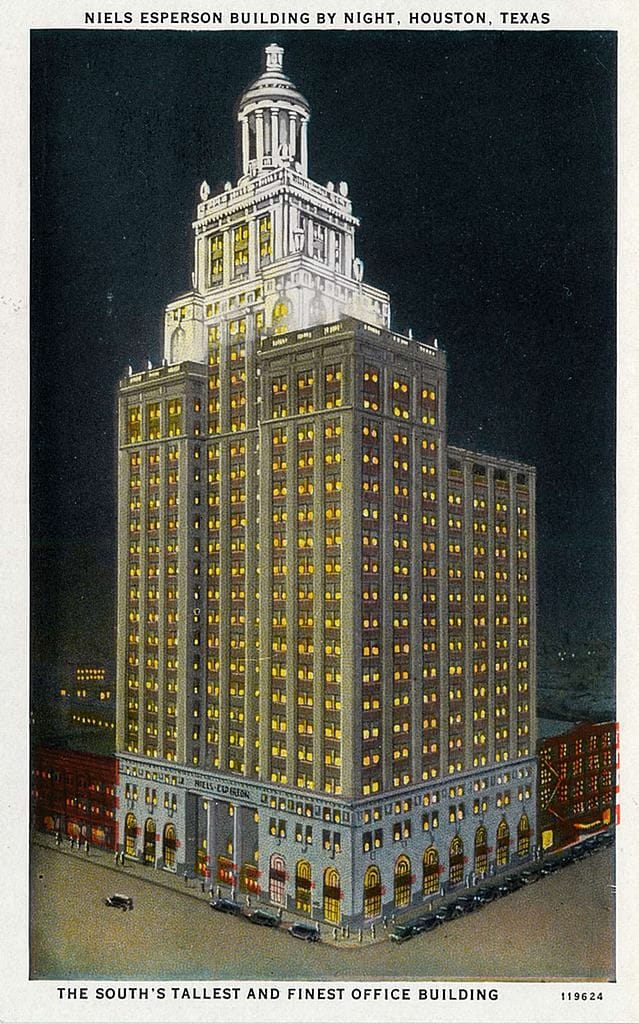Early Beginnings: The Birth of Houston’s Architectural Identity
Houston’s skyline began its rise in the early 20th century, fueled by the discovery of oil and the city’s strategic location as a shipping and railroad hub. The city’s first skyscraper, the Niels Esperson Building, was completed in 1927 and remains a symbol of Houston’s growth. Designed in Italian Renaissance style, the building’s lavish exterior set it apart from the minimalist styles seen in other cities at the time.

As Houston continued to grow, so did the demand for office space, leading to the construction of buildings like the Gulf Building (now known as the JPMorgan Chase Building). Completed in 1929, this Art Deco masterpiece remains a significant part of the city’s architectural heritage. These early structures laid the foundation for Houston’s ambitious expansion, showcasing its rapid development and the bold designs that would eventually shape one of the most impressive skylines in the United States.

The 1970s Boom: Houston’s Transformation into a Major Metropolis
The 1970s saw Houston transform dramatically. As the energy industry flourished, so did the city’s economy, prompting a construction boom that reshaped the skyline. The most iconic structure from this era is One Shell Plaza, completed in 1971. Towering at 715 feet, it was Houston’s tallest building at the time, embodying the city’s upward aspirations. This era also introduced Houston to glass-clad skyscrapers, which reflected the city’s modern outlook and love for innovation.

During this boom, Pennzoil Place stood out with its innovative design, two trapezoidal towers that seem to merge. The building’s unique structure gained national attention and set a new standard for Houston architecture, emphasizing creativity over mere height. By the end of the decade, Houston’s skyline had evolved from a modest cluster of buildings to a bustling metropolis known for its architectural diversity and impressive height.

The Rise of the Tallest: Williams Tower and the Chase Tower
In the 1980s, Houston continued to break new ground with the completion of Williams Tower and JPMorgan Chase Tower.
Standing at 901 feet, Williams Tower became the tallest building outside a central business district, symbolizing Houston’s expanding economic reach. Known for its sleek, reflective facade and elegant shape, Williams Tower redefined the visual appeal of the city’s skyline and has become one of Houston’s most recognizable structures.

Meanwhile, JPMorgan Chase Tower, completed in 1982, claimed the title of the tallest building in Texas at 1,002 feet. Its commanding height and innovative design by architect I.M. Pei made it a standout piece in Houston’s architectural landscape. The building’s staggered shape and use of natural light showcased Houston’s commitment to both functionality and beauty. These towering additions positioned Houston as a city of architectural ambition, attracting architects and builders who would continue to shape its skyline in the decades to follow.

Modern Icons: Green Architecture and Sustainable Design
In recent years, Houston has embraced sustainable architecture, focusing on eco-friendly building practices. The Bank of America Tower, completed in 2019, is a prime example, earning LEED Platinum certification, the highest standard in sustainable building. This modern skyscraper features a unique glass design that maximizes natural light while minimizing energy consumption, reflecting Houston’s commitment to environmental responsibility.

Texas Tower, another recent addition, has set new standards for luxury and sustainability. Completed in 2021, this 47-story office tower utilizes green building practices, including rainwater harvesting and energy-efficient systems. These modern skyscrapers represent Houston’s shift towards green architecture, blending innovation with a commitment to reducing the city’s carbon footprint. Houston’s skyline now includes not only historical masterpieces and bold modernist designs but also forward-thinking structures that align with the city’s future-focused vision.

Houston’s Skyline Today: A Blend of History and Innovation
Today, Houston’s skyline reflects a mix of historic charm and cutting-edge innovation. Each building tells a unique story of the city’s growth, resilience, and adaptability. From the elegance of the Niels Esperson Building to the modern efficiency of Bank of America Tower, Houston’s skyline serves as a testament to the city’s enduring spirit and ambition.
Houston’s skyline is more than just a collection of buildings – it symbolizes the city’s identity and progress. The town has embraced architectural innovation and historical preservation, creating a skyline that resonates with locals and impresses visitors. For Houstonians, the skyline is a point of pride, a daily reminder of how far their city has come and the bright future ahead.